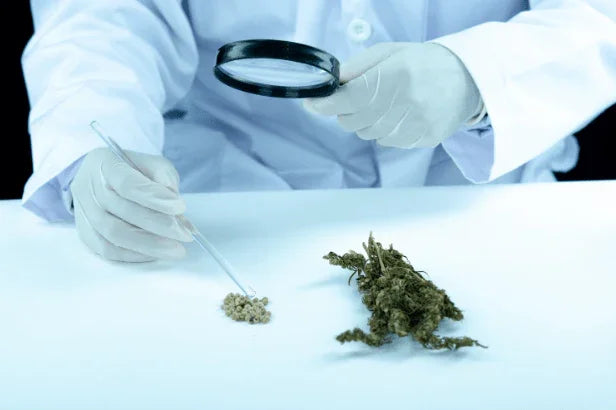Cannabis, a plant with a history as rich and complex as its effects, has long been a subject of curiosity and study. Among the many questions that enthusiasts and researchers alike seek to answer, one stands out for its direct impact on the user experience: How many milligrams of THC are in a joint? Recently, pot experts have come forward with a new estimate that aims to shed light on this intriguing question, offering valuable insights into the potency of cannabis joints and their effects on consumers.
How many milligrams of THC are in a joint?
Determining the milligrams of THC in a joint depends on various factors, such as the strain of cannabis used, the size of the joint, and how it's prepared. Generally, a typical joint might contain anywhere from 10 to 150 milligrams of THC, but this can vary widely. It's crucial to understand the potency of the cannabis being used and to dose accordingly to avoid potential adverse effects. Consulting with a knowledgeable budtender or conducting research on the specific strain can provide more insight into the THC content. Ultimately, knowing the milligrams of THC in a joint can help users make informed decisions about their cannabis consumption. Here's a breakdown of factors influencing THC content and how to estimate it:

Demystifying THC Dosage
Understanding THC dosage is essential for individuals new to cannabis as well as experienced users alike. Factors such as the strain of cannabis, the potency of the flower, and the size of the joint can all influence the amount of THC consumed. By grasping these variables, users can better manage their cannabis experience and tailor it to their desired effects.
Cannabis Strain and Potency
The potency of a joint's THC content is heavily influenced by the specific cannabis strain utilized, with strains like "Sativa" or "Indica" exhibiting varying levels of potency. These differences in potency can significantly influence the user's overall experience, highlighting the importance of understanding and selecting strains based on individual preferences and tolerance levels.
Cultivation Techniques
Various aspects of cannabis cultivation, including environmental conditions, nutrient management, and harvesting techniques, play pivotal roles in determining the potency of THC within the plant. Factors such as optimized growing environments, balanced nutrient compositions, and precise harvesting procedures collectively influence the ultimate concentration of THC present in the cannabis product.
Joint Size and Rolling Technique
The size and density of the joint, along with the rolling technique employed, play crucial roles in determining the quantity of cannabis and THC concentration within. A tightly rolled joint not only holds more cannabis but also ensures a higher concentration of THC, whereas a loosely rolled one may offer a lighter dosage due to less compactness.
Lab Testing and Labeling
In areas where cannabis is legally accessible, products undergo rigorous laboratory testing to ensure both potency and safety. Learning how to decipher these labels empowers consumers to make informed decisions about the THC levels present in their joints, enhancing their overall cannabis experience.
The Science of THC Content in Cannabis
Understanding the THC content in cannabis involves more than just a simple measurement. It's a complex interplay of plant genetics, cultivation conditions, and processing methods. This section will explore the botanical and chemical processes that determine THC levels in cannabis, providing a scientific foundation for the discussion. Here are some key points to consider:
- Chemical Composition: THC is one of many cannabinoids found in cannabis plants. Its concentration can vary significantly depending on the strain and growing conditions.
- Lab Testing: In regions where cannabis is legal, products are typically subjected to laboratory testing to determine their THC content. This testing involves precise analytical methods to quantify the amount of THC present.
- Strain Variability: Different strains of cannabis can have vastly different THC concentrations. For example, some strains may have high levels of THC, while others may have lower levels or contain more CBD, another cannabinoid with different effects.
- Effects on Users: The potency of THC can directly impact the psychoactive effects experienced by users. Higher THC concentrations may result in more potent euphoria, while lower concentrations may produce milder effects.
- Legal Considerations: Understanding THC content is essential for compliance with regulations in legal cannabis markets. Many jurisdictions have specific limits on the amount of THC allowed in products sold to consumers.

Factors Affecting THC Concentration in Joints
Several factors contribute to the variability of THC concentration in joints, making each experience uniquely personal. These factors range from the quality and strain of the cannabis used to the size and construction of the joint itself. This section will break down these elements in detail, offering readers a comprehensive view of what affects the potency of their joints.
- Growing Conditions: Environmental factors such as light, temperature, humidity, and nutrient levels can impact THC production in cannabis plants. Optimal growing conditions can result in higher THC concentrations.
- Harvest Time: The timing of the harvest can affect THC levels. Harvesting too early or too late can result in lower THC content, as the cannabinoid levels peak during specific stages of the plant's growth cycle.
- Curing and Drying: Proper curing and drying techniques are essential for preserving THC levels in harvested cannabis. Improperly dried or cured cannabis can degrade THC and other cannabinoids.
- Extraction Methods: For products like concentrates and edibles, extraction methods can impact the final THC concentration. Different extraction techniques may result in varying levels of THC potency.
The Importance of Awareness
Understanding the THC content in cannabis products is essential as it enables individuals to make informed choices about their consumption habits, promoting responsible use and minimizing potential risks. This knowledge empowers users to gauge their tolerance levels accurately and ensure they're consuming cannabis products in a manner that aligns with their personal preferences and health goals. Here's why it matters:
- Dosage Control: Knowing the THC content allows consumers to control their dosage and avoid consuming more than intended, reducing the risk of adverse effects such as anxiety or paranoia.
- Health and Safety: High THC concentrations may pose risks, particularly for novice users or those with underlying health conditions. Being aware of THC levels can help individuals make choices that prioritize their health and well-being.
- Legal Compliance: In jurisdictions where cannabis is legal, understanding THC content is essential for complying with regulations governing the purchase, possession, and consumption of cannabis products.
- Personal Preferences: Some individuals may prefer products with higher or lower THC concentrations based on their tolerance, desired effects, or medical needs. Awareness of THC content allows consumers to select products that align with their preferences.
FAQs
What is the average THC content in a standard joint?
The average THC content in a standard joint can range from 10mg to 30mg, but it ultimately depends on factors like strain and cultivation methods.
Can joints with higher THC content pose risks?
Joints with higher THC content may induce more substantial psychoactive effects and increase the likelihood of adverse reactions, especially for users with low tolerance levels.
How can I determine the THC content of a joint without lab testing?
While lab testing provides accurate results, estimating THC content based on factors like strain, appearance, and scent can offer some insight into potency.
Are there any ways to mitigate the effects of high-THC joints?
Consuming CBD alongside THC can help mitigate some of the psychoactive effects, providing a more balanced experience for the user.
What precautions should users take when consuming high-THC joints?
It's essential to start with small doses, especially for inexperienced users, and to consume cannabis in a safe and controlled environment.
How does THC dosage affect medical cannabis users?
Medical cannabis users should consult with healthcare professionals to determine appropriate THC dosage based on their specific medical conditions and treatment goals.
Conclusion
In conclusion, the milligrams of THC in a joint can vary significantly, influenced by factors such as strain, cultivation methods, and joint size. By understanding these variables and practicing responsible consumption, individuals can enjoy cannabis safely and responsibly.





